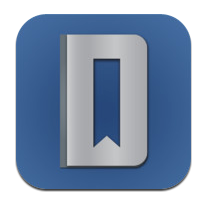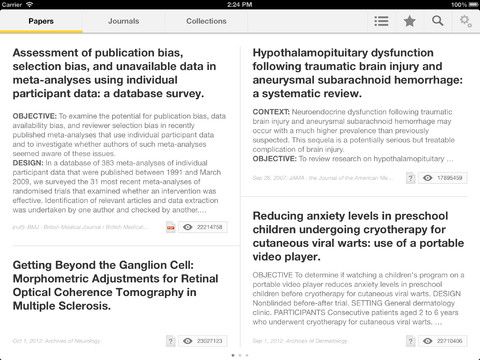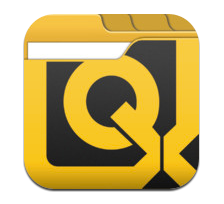Article
docwise vs. Read by QxMd: Which medical journal app should you use?
We've taken a close look at the two medical journal and news-reading apps, docwise and Read by QxMD, that provide the best experience.
Reading new medical research isn't necessarily an easy task. Physicians read multiple journals in various specialities, leaving a large body of research to scan and tackle. Not only that, but sometimes speciality relevant research doesn't even show up in journals specific to a physician's specialty! But there's hope in making this frustrating experience a bit easier. The distribution and organization of medical research and news is something that our phones and tablets are quite capable of handling. We looked at two apps that could potentially make life easier for physicians to keep up with that medical research., docwise and Read by QxMD.
The main theme among the healthcare reader apps is to simplify the experience of keeping up on medical research and healthcare news. The two apps we looked at seem to be doing the best job of optimizing the experience. docwise takes a design-centric approach with a healthy mix of both healthcare news and medical journals. Whereas Read by QxMD is more focused on the medical journals and making as many available as possible. The short verdict is that docwise provides a significantly better reading experience (similar to popular Zite and Flipboard) while Read by QxMD provides access to more journals. But let's dig into each app.
docwise


docwise inc. was started by healthcare tech entrepreneur, Rosina Samadani, PhD. and Prashant Sinha, MD. In my interview with Samadani, she started by explaining their purpose, "We built this app to help physicians stay up to date on their journals, news, and customized topics of interest." She went on to express a desire to make the medical journal and news reading experience "efficient and enjoyable."
I was immediately drawn to docwise from the second I saw a screenshot; it reminded me of my favorite news app, Zite. Once downloaded, the similarities in user experience to Zite and Flipboard continue. Once the journals, news sources, and topics the user wants to follow are added, the user can flip through the digital magazine it creates. Sources can be browsed all together, individually, or by type (news, journals, or topics). The ability to customize this personalized healthcare magazine with the sources each user wants is satisfying. Samadani explained, "We really want physicians to feel like it's their app."
The app is packed with features including 1,417 journals (more added daily), various news sources, alerts when the full text of an article is available, logins via institution, keyword-based sources, search, a reading list to save articles for latter consumption, a library to save important research and articles for later reference, and embedded video and audio for articles with associated multimedia. An interesting feature that was recently expanded in an update is the tracking of CME2 credits. The app tracks the number of articles viewed and the time spent in the app. And at the end of the year, the app will email the user a certificate for CME2 credits.
During our interview, I took interest in the polling feature and social interactions. A poll is presented to users on the main headlines page. This poll is run by docwise physicians and even allows users to submit their own questions. This ability for users to help shape the app was a recurring theme in my talk with Samadani. The poll is user-contributed and almost all requests for new journals to the app are added. Even answers to my questions about where docwise wants to go with social media was heavily focused on going the direction their users are comfortable with. "This is a platform where social media is a natural," Samadani said. "This community has been burned in the past by social media types of communities focused on physicians. We want to proceed intelligently, carefully, and respectfully of the audience that we have… We want to go gently and not make a single mistake."
Future updates for docwise include an iPhone version (about 8 weeks from now), the ability to add RSS feeds, the ability to request institutions, and Dropbox-like folders to share and tag articles. My favorite upcoming feature is a Zite-like algorithm that will suggest new content to users based on their reading habits.
There's a real dedication to the physician community from the docwise team. I got the feeling that all physician requests will be taken seriously and acted upon in some way. So my suggestion is to download the app, add all of the sources you're interested in, and send a list of whichever journals and sources that are missing (if there are any) to the docwise team.
Read by QxMD


Read by QxMD is another journal-reading app for the iPhone and iPad created by the makers of popular clinical calculator and decision support tool, Calculate by QxMD. In fact, Calculate is so popular that most of the promotion efforts for Read by QxMD go to users of the their clinical calculator that's been downloaded 650,000 times. Read by QxMD itself has been downloaded about 20,000 times. Where docwise is focused on the entire reading experience of the physician, Read specializes in journals. Like docwise, we reached out to QxMD for an interview. I interviewed Daniel Schwartz, MD, Medical Director & Co-founder of QxMD.
Schwartz started by explaining the purpose behind Read. "The reason why we built Read was to find a solution to connect clinicians, healthcare providers, doctors with the source of medical research," he said. Schwartz went on to explain the problems with finding medical research relevant to individual doctors. He explained that Read is about "connecting people with personalized content and then allowing them to actually read it." The app also has hints of Zite and Flipboard in its design, as most successful newsreader apps do. The app links up with the PubMed interface (licensed by the National Library of Medicine) to provide users with 360 journals (expanding to 6,300 in the next update).
Customization isn't a focus for Read like it is with docwise. Read favors a more automatic solution to the content distribution. Schwartz explained, "Using our algorithms, we think we can pick what people want to read." But he went on to mention that in the future, customization may not go as far as allowing users to add their own RSS feeds, but there may be more customization capabilities. Keeping up with their efforts to making physician journal-reading efforts easier, Schwartz brought up the problems with the actual delivery of medical research and how Read helps solve that solution with push notifications to "get people the content as quickly and as simply as possible, and in a timely fashion."
More features of Read include a large article database provided by PubMed, access to full text via university/institutional subscription, the ability to save articles for later consumption and reference, and a tagging system to help keep articles organized. I was particularly impressed with the labeling feature for saved articles. It was easy to create a new label and start assigning articles to those categories for later reading. For someone who likes to keep a large, organized library of journal articles to read at a later time, this feature will be a useful tool.
Wrap-up
I asked both companies what their plans were for monetization (neither are currently monetizing the apps in any way). The apps are going in opposite directions in this area. docwise is going to keep all of the functionality of the app free and support the app with advertising. Samadani promises that "advertising will be very discreet…and elegant." The company is currently in talks with advertisers. Read by QxMD is planning on implementing a "freemium" model. They will eventually start offering extra features for "premium users" that subscribe to their service, while leaving the rest of the features free.
Ultimately, docwise seems to have the upper hand with design and user experience, while Read by QxMD has the larger journal library – 1,417 vs. 6,300 journals (after the coming update). But the larger journal selection isn't necessarily an overwhelming advantage. With docwise adding journals daily by request, it will likely offer nearly 100% of the desired journals for its user base. With Read by QxMD getting to the starting line first, docwise is playing catchup with a smaller user base. But in terms of app quality, they are competitive.
Download both. But I think most physicians will find their finger drifting towards docwise on a daily basis.





